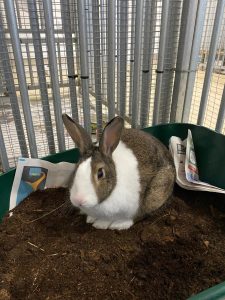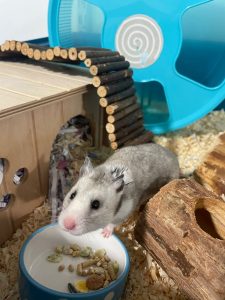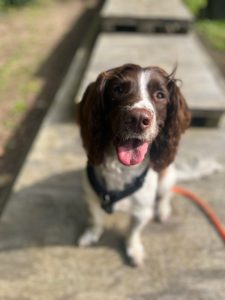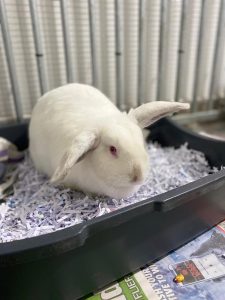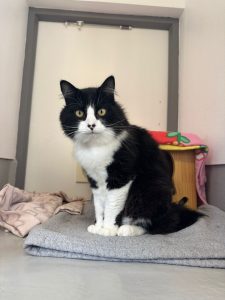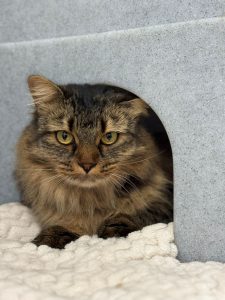Love it or hate it, it’s nearly Hallowe’en. For some it’s a great time to enjoy pumpkin carving, apple bobbing, and Trick or Treat, but this can be a very scary time for our pets.
We have created these tips about how you can keep your pets safe this Hallowe’en.
Keep Hallowe’en treats out of reach from your pets
At this time of year and through until the end, we often have more sweets and chocolates in the house than normal. This could mean your pet could get their paws on something they shouldn’t. Chocolate in all forms can be very dangerous to your pets, as can raisins. Any sugary sweets containing xylitol can also cause serious problems. If you suspect your pet has eaten anything they should not have, please contact your Vet ASAP!
Ensure your pet is identifiable if they escape (e.g. collar and tag, microchip etc)
If your home sees multiple visitors at Hallowe’en due to parties or Trick or Treat, there is a greater chance of your pet taking a chance and making a run for it. Ensure your dog is wearing its collar with ID tag attached. And if your pet is microchipped we cannot express the importance of ensuring that the details are kept up-to-date. This can be done by contacting the microchip company to check / amend your details. If you’d like to microchip your pet, please speak directly with your Vet.
Consider walking your dog earlier and in daylight
Bumping into people wearing strange costumes in the dark – and possibly more people than your dog is used to – could be very scary for them, so consider heading out earlier than normal or wait until most people are back indoors.
Keep the Hallowe’en decorations away from pets
If you’re having a party at home, or you simply like dressing up your house for the occasion, ensure that decorations are kept out of reach from your pet and away from its cage / bed etc. Sparkly, dangly, smelling unusual? All these will tempt your pet to become very interested in what these new things are around the house. Any open flames from candles, or inside pumpkins, should be kept well away from your pet.
Provide your pet with a hideaway safe area
With all the extra visitors, noise and smells, your pet could feel a little unsafe and unsure, even in their own home. It is important to give them a hideaway place they can retreat to if needed. Ensure the hideaway has a supply of water and food, close the curtains and maybe put on some calming music or the TV to help drown out any extra sounds from outside. You might even consider dedicating a room as your pet’s hideaway where there are no decorations and everything is normal so that they feel safe and familiar.
Consider bringing outdoor pets inside for the night
If you have pets that live outside or who have access to outside, you may wish to consider bringing them indoors to protect them from too much noise or from getting spooked and running away.
We wish you and your pets a very safe and happy Hallowe’en.
Keeping your pets safe and happy on Guy Fawkes’ Night by Kari Lees, Animal Behaviourist DipCABT
Also, at this coming time of year, we can start to expect fireworks. This can be an extremely frustrating time for owners of pets that find them frightening, and can leave owners feeling quite helpless. Ideally, you should start to desensitise your pet to fireworks and thunderstorms months before they happen, so here are some tips of how you can help:
SAFE DEN
Create a comfortable, covered space that your pet can retreat to when frightened. For cats, this could be a cardboard box with a soft, fleece blanket inside. And for dogs, it could be a covered crate or a duvet behind the couch or under a table with a cover over the top.
PHEROMONES
Feliway and Adaptil (DAP) products have been shown to help relax pets. These can be purchased from the JSPCA Animals’ Shelter, your Vet or online.
MEDICATION
Discuss the option of medication with your Vet and find out what would be suitable.
KEEP PETS INDOORS
Keep your cat shut in before it becomes dark and when you know there is a risk of fireworks being set off. Remember to lock the cat flap and shut all windows. Some cats will break through a locked cat flap so place something in front of it once they’re inside. Dogs should be exercised before it is dark and if you have to take him or her out to the toilet, keep them on a lead and ensure they are wearing a proper fitting harness or collar. If frightened by a firework or thunder clap, there is a risk that they might run away.
TURN ON THE TV OR RADIO AND SHUT WINDOWS AND CURTAINS
This can help to drown out some of the noises and lights and flashes of the fireworks.
COMFORT YOUR DOG OR CAT
Some animals really want affection when they are frightened and it is okay to cuddle them. Some dogs can be distracted by play or being given something tasty to chew. Some cats might happily munch on a few treats. It really depends on your pet. If something works to make them feel safer, then there is no harm in doing that for them.
VISIT ANOTHER PARISH
If you know the times of the display, take your dog for a drive so they can no longer hear the fireworks and let them explore a new area or just enjoy a nice drive.
HELP YOUR SMALL ANIMALS SUCH AS RABBITS AND GUINEA PIGS TO COPE WITH FIREWORKS
The flashes and sounds of fireworks could frighten small animals, so bring their hutch inside for the evening. If you notice any change in your rabbit or guinea pig – such as not eating – please take them to a Vet, as the stress of the fireworks may affect their health.
HELP YOUR HORSES COPE WITH FIREWORKS
It depends on where your horse feels safest, some need to be stabled during fireworks and some might feel trapped in a stable and would be better in the paddock. Stay with your horses during fireworks so that you can support them if they become afraid. If possible, it may be best to move your horse to a different field or stables during the fireworks display.
DESENSITISATION
Training your animal to not be frightened of fireworks is a process that can take months, so please start well before fireworks are most likely due. This example is tailored around dogs, but you could try alternatives for other pets.
- Do the training at a time of evening that your pet is most calm and in a room in which they usually relax.
- You will need to try to replicate firework sounds in the training and this can be done by purchasing CDs with firework sounds such as CLIX Noises and Sounds CD. There are many options, such as downloading the app called Pup School; going online to YouTube for fireworks sounds; or trying Dog’s Trust Sounds Scary, which has tracks of firework sounds.
- Prepare the room. Pheromones can be used to help reduce anxiety so you can use Adaptil (for dogs) or Feliway (for cats) in the room you intend to use for training.
- Create a lovely, comfortable den in which your pet can relax.
- Shut the windows and close curtains.
- Put on sounds that could help create a relaxing atmosphere such as ‘Through a Dog’s Ear’ music for dogs, audio books or turn on the TV.
- Provide your dog with something to eat that he or she will enjoy and will last for a while. Filled Kongs work nicely for this.
Training
- Start the fireworks sounds at a volume that your pet does not find scary. That might mean that you can’t hear it.
- Straight after the sounds have started playing give them their Kong, toy, treats or lie down with them and gently stroke them. Whatever you choose, make sure it is something that they enjoy.
- Repeat this every day. Be sure to stay on the same volume for a few days before increasing the volume.
- Increase the volume very gradually over the next few days.
- Once your pet is desensitised to one lot of sounds, start again, at a low volume, with another set of sounds.
This really will be a slow, gradual process. If you try to rush it and play the sounds at a volume your pet finds scary, you are not desensitising them and you are still making them feel fearful around fireworks. It is important during a desensitisation process to avoid a fireworks event as this could undo all of your work. If there are fireworks are due to be set off, speak to your Vet about medication during the event or take your dog for a drive to another area where they won’t hear the fireworks.
Perhaps this year, as an alternative approach to fireworks night, you could use the money you would normally spend on fireworks to instead buy an item from our Amazon Wish List: https://amzn.to/39qbB5B This 5th November, don’t make a noise, make a difference!
How we can help wildlife in winter
As winter approaches, we can all often struggle when the weather takes a turn for the worse, but our wildlife friends are often the most vulnerable in the extreme elements. Here are some ideas of how we can help them through the winter…
Garden birds
Birds may have difficulty finding normal food in winter, so please consider leaving out extra food for them, such as cooked pasta, rice or boiled potatoes, cheese, uncooked and unsalted bacon rind, raisins and sultanas, apples, pears and soft fruits, and insects such as mealworms or waxworms.
Squirrels
Squirrels ‘cache’ or store food when it’s in good supply, ready to eat when food is harder to come by. To help squirrels during winter, leave hazelnuts, walnuts, almonds, chopped apple, beans, carrots or spinach somewhere safe and out of reach of predators in your garden.
It’s important not to leave out large quantities of food each evening to avoid your visitors becoming dependent on handouts. It’s also not advisable to provide food if it’s going to encourage wildlife to cross a busy road.
Protect pondlife
Toxic gases can build up in frozen ponds, killing fish or frogs which may be hiding at the bottom. If you have a pond and the weather gets particularly bitter, please check for ice every day. If you notice that the pond has frozen over, carefully place a saucepan of hot water on the surface to melt a hole. Never tip boiling water on to it or break the ice, as this can harm the pondlife. You can also float a tennis ball or similar in your pond to prevent it freezing over completely. It’s also a good idea to create a nearby rock pile where creatures can take shelter.
Take a walk on the wild side
Leave some undisturbed areas in your garden to go wild. Piles of leaves can be used to make the perfect nest in which animals can hide, rest and hibernate. Leave tidying your garden borders and shrubs until early spring as these will provide insects with shelter throughout the winter. Consider creating a compost heap as this will become a welcome habitat for toads, and even grass snakes and slow-worms. Just be careful not to disturb anything living in there.
Hibernation
If you’re clearing your garden of leaves, please check the piles for any animals such as hedgehogs, frogs and mice who find these cosy spots to hibernate. Please also check wood piles or bonfires before lighting them. If you find wild animals in hibernation, be sure to leave them be.
Keep water available
Place a shallow dish of fresh water on the ground to benefit all garden wildlife, including birds. You could also invest in a bird bath to keep birds hydrated and clean.
By putting out additional food and making some small differences in our gardens, we can all make a significant contribution to supporting wildlife over the winter. It is also a great way to watch wildlife even in the smallest gardens or balconies.
